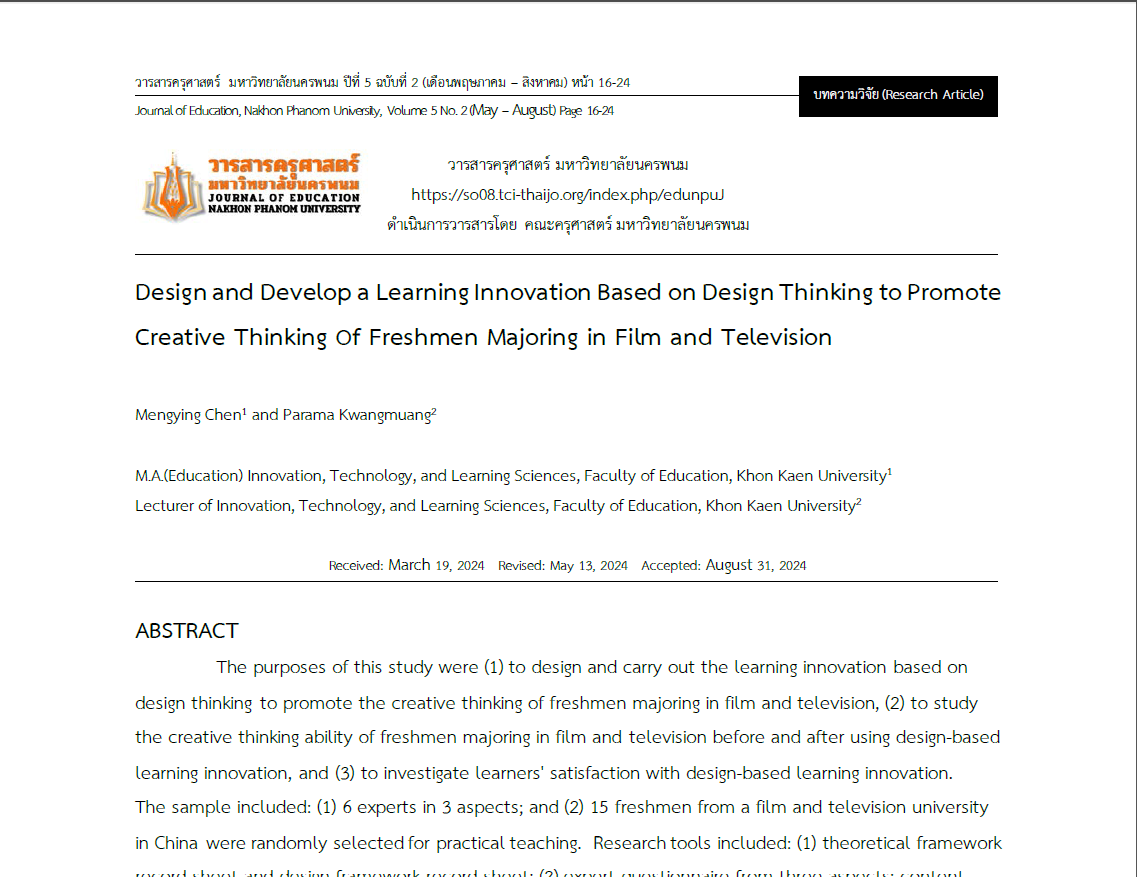Design and Develop a Learning Innovation Based on Design Thinking to Promote Creative Thinking Of Freshmen Majoring in Film and Television
Main Article Content
บทคัดย่อ
The purposes of this study were (1) to design and carry out the learning innovation based on design thinking to promote the creative thinking of freshmen majoring in film and television, (2) to study the creative thinking ability of freshmen majoring in film and television before and after using design-based learning innovation, and (3) to investigate learners' satisfaction with design-based learning innovation. The sample included: (1) 6 experts in 3 aspects; and (2) 15 freshmen from a film and television university in China were randomly selected for practical teaching. Research tools included: (1) theoretical framework record sheet and design framework record sheet; (2) expert questionnaire from three aspects: content, media and design; (3) before and after assessment of students' creative thinking ability (fluency thinking, thinking flexibility, creative thinking, and detailed thinking); and (4) students' satisfaction with learning innovation questionnaire based on design thinking. This study adopted the research method of Richy and Kline (2007), which included three stages: design, development and evaluation.
The results showed that: (1) the innovative learning environment based on design thinking was consistent with the theoretical framework record table and the design framework record table; (2) both the pre-test and post-test of the four dimensions of creative thinking showed differences (p<0.01), that was, students' creative thinking ability improved significantly after teaching; (3) integrating the three aspects, the mean score ( ) was 4.10 and the standard deviation (S.D.) was 0.59, indicating that students were satisfied with the learning innovation based on design thinking.
Article Details

อนุญาตภายใต้เงื่อนไข Creative Commons Attribution-NonCommercial-NoDerivatives 4.0 International License.
บทความที่ได้รับการตีพิมพ์เป็นลิขสิทธิ์ของวารสารครุศาสตร์ คณะครุศาสตร์ มหาวิทยาลัยนครพนม ข้อความที่ปรากฏในบทความแต่ละเรื่องในวารสารครุศาสตร์เล่มนี้เป็นความคิดเห็นส่วนตัวของผู้เขียนแต่ละท่านไม่เกี่ยวข้องกับมหาวิทยาลัยนครพนม และคณาจารย์ท่านอื่น ๆ ในมหาวิทยาลัยฯ แต่อย่างใด ความรับผิดชอบองค์ประกอบทั้งหมดของบทความแต่ละเรื่องเป็นของผู้เขียนแต่ละท่าน หากมีความผิดพลาดใด ๆ ผู้เขียนแต่ละท่านจะรับผิดชอบบทความของตนเองแต่ผู้เดียว
เอกสารอ้างอิง
Lu Y H. (2016). Research on current situation and talent training strategy of film and television education
in Chinese universities. Southeast Transmission (07), 153-157.doi:10.13556/j.cnki.dncb.cn35-
/j.2016.07.050.
Gao Y. (2019). Research on current situation and talent training strategy of film and television education
in Chinese universities. Art Education (01), 120-121.
Chaijaroen, S., Kanjug, I., & Samat, C. (2012). Development and efficiency improvement of the learning
innovations enhancing learners’ thinking potential. Procedia - Social and Behavioral Sciences, 46,
–3464. https://doi.org/10.1016/j.sbspro.2012.06.085.
Kwangmuang, P., Jarutkamolpong, S., Sangboonraung, W., & Daungtod, S. (2021). The development of
learning innovation to enhance higher order thinking skills for students in Thailand junior high
schools. Heliyon, 7(6), e07309. https://doi.org/10.1016/j.heliyon.2021.e07309.
Hannafin, Michael & Land, Susan & Oliver, Kevin. (1999). Open Learning Environments: Foundations,
methods, and models.
Yu Hongyan & Zhu Guanghui. (2019). Thinking on Cultivating Students' Innovative Skills Based on Design
Thinking. Journal of Changchun University (10), 58-61.
Chen Yanyan & CAI Wenyi.(2020). Creativity Cultivation based on Design Thinking. Shanghai Education and
Scientific Research (11), 15-20. doi:10.16194/j.cnki.31-1059/g4.2020.11.004.
CAI Lingyu & Tai Jie.(2024). The Cultivation of Innovative Ability of Design Students: A case study of "Design
Thinking" course. Design (02), 134-137. doi:10.20055/j.cnki.1003-0069.001489.
Kwangmuang, P., Jarutkamolpong, S., Sangboonraung, W., & Daungtod, S. (2021). The development of
learning innovation to enhance higher order thinking skills for students in Thailand junior high
schools. Heliyon, 7(6), e07309. https://doi.org/10.1016/j.heliyon.2021.e07309.


